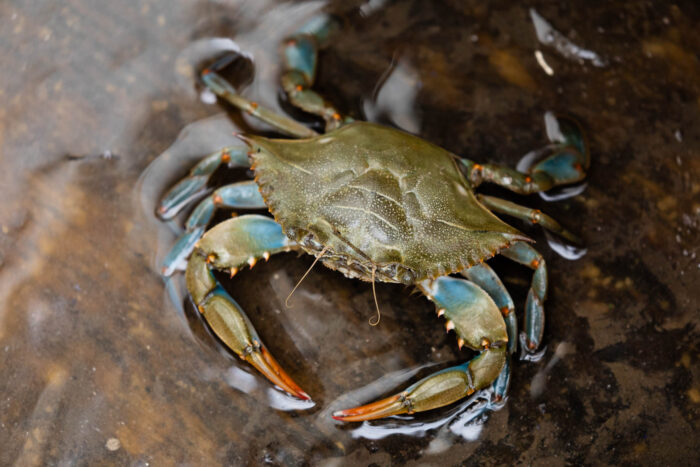Blue crab
Callinectes sapidus
The blue crab is a swimming crustacean with bright blue claws and an olive green shell. It is one of the most recognizable species in the Chesapeake Bay.
This section shows one large critter image at a time. Use the thumbnails that follow to select a specific image to display here.

This gallery contains a grid of small thumbnails. Selecting a thumbnail will change the main image in the preceding section.
Appearance
The blue crab's carapace (shell) varies in color from bluish to olive green, and can reach up to 9 inches across. The carapace has nine marginal teeth on each side; the ninth teeth are strong spines. Its claws are bright blue, and those of mature females feature red tips.
Blue crabs have three pairs of walking legs and paddle-shaped rear swimming legs. Males have a strongly tapered abdomen, or "apron," that resembles an inverted T. Mature females have a broad, rounded apron, and immature females have a triangular apron.
Feeding
Blue crabs will feed on nearly anything they can find, including clams, oysters, mussels, smaller crustaceans, freshly dead fish, and plant and animal detritus. They will even eat more vulnerable soft-shelled blue crabs and small juveniles.
Predators
Blue crab predators include large fish like striped bass, Atlantic croaker and red drum. Predatory birds, such as blue herons, and sea turtles are also known to feed on smaller crabs.
Reproduction and life cycle
Blue crabs mate from May through October in the brackish waters of the Chesapeake Bay. Prior to mating, males will cradle a soft-shelled female in their legs, carrying her for several days while he searches for a protected area for her final molt. Once she molts, the pair mates. After mating, the male continues to cradle the female until her shell hardens. Males eventually leave to search for another mate, while females migrate to the saltier waters of the lower Bay.
As they migrate toward the mouth of the Bay, females develop an external egg mass, or sponge, beneath their aprons. Each bright orange egg mass may contain between 750,000 and two million eggs. The egg mass darkens as the developing larvae consume the orange yolk. After about two weeks, larvae are released near the mouth of the Bay.
Currents transport the blue crab larvae, called zoea, out into the coastal waters, where they molt several times as they grow. After four to eight weeks of development in the coastal ocean, the zoea return to the brackish waters of the Bay. During their last larval molt, zoea metamorphose into a post-larval form called the megalopa.
Megalopae are pushed back into the estuary by wind and tidal currents, settling in key nursery habitats such as seagrass beds and marsh fringes.. Megalopae eventually metamorphose into immature crabs, which look like tiny adults. Immature crabs molt several times before they reach maturity, about 12 to 18 months after hatching. Few blue crabs live longer than three years.
Did you know?
- The blue crab’s scientific name comes from the Greek words for “beautiful” and “swimmer.”
- Male blue crabs are known as “jimmies,” while mature females are called "sooks."
- Blue crabs are one of the most important commercial and recreational catches in the Chesapeake Bay.
- The Chesapeake Bay blue crab population has not been overfished since female-specific management was implemented in 2008.
Sources and additional information
- Life in the Chesapeake Bay by Alice Jane Lippson and Robert L. Lippson
- Chesapeake Bay: Nature of the Estuary, A Field Guide by Christopher P. White
- Maryland Fish Facts: Blue Crab – Maryland Department of Natural Resources
- Animal Diversity Web: Callinectes sapidus – University of Michigan Museum of Zoology
